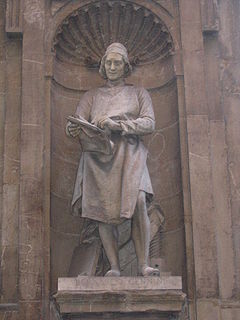
Bernardo Cennini
Encyclopedia

Italy
Italy , officially the Italian Republic languages]] under the European Charter for Regional or Minority Languages. In each of these, Italy's official name is as follows:;;;;;;;;), is a unitary parliamentary republic in South-Central Europe. To the north it borders France, Switzerland, Austria and...
goldsmith
Goldsmith
A goldsmith is a metalworker who specializes in working with gold and other precious metals. Since ancient times the techniques of a goldsmith have evolved very little in order to produce items of jewelry of quality standards. In modern times actual goldsmiths are rare...
, sculptor and early printer of Florence
Florence
Florence is the capital city of the Italian region of Tuscany and of the province of Florence. It is the most populous city in Tuscany, with approximately 370,000 inhabitants, expanding to over 1.5 million in the metropolitan area....
. As a sculptor he was among the assistants to Lorenzo Ghiberti
Lorenzo Ghiberti
Lorenzo Ghiberti , born Lorenzo di Bartolo, was an Italian artist of the early Renaissance best known for works in sculpture and metalworking.-Early life:...
in the long project producing the second pair of doors— the Doors of Paradise— for the Battistero di San Giovanni
Battistero di San Giovanni (Florence)
The Florence Baptistry or Battistero di San Giovanni is a religious building in Florence , Italy, which has the status of a minor basilica....
. He produced the first book printed at Florence. The painter and author of a famous book on the crafts, Cennino D'Andrea Cennini
Cennino D'Andrea Cennini
Cennino d'Andrea Cennini was an Italian painter influenced by Giotto. He was a student of Agnolo Gaddi. Gaddi trained under his father, called Taddeo Gaddi, who trained with Giotto. Cennini was born in Colle Val d'Elsa, Tuscany....
, was a member of the same Florentine family.
Works of sculpture and goldsmith
Representing his output as a sculptor-goldsmith is a cache of his sculptures in silver that are preserved in the Museo dell'Opera del DuomoMuseo dell'Opera del Duomo (Florence)
The Museo dell'Opera del Duomo in Florence, Italy is a museum containing many of the original works of art created for the Basilica di Santa Maria del Fiore, the cathedral of Florence. The museum is located just east of the Duomo, near its apse...
, Florence. They include a high relief combining two New Testament episodes, The Announcement to Zachariah and the Visitation, which were Cennini's contribution to the silver altar of S. Giovanni, (formerly in the Baptistery), a project that was worked on by several generations of sculptors; the silver crosses for it are also by Cennini, and the corpus
Crucifix
A crucifix is an independent image of Jesus on the cross with a representation of Jesus' body, referred to in English as the corpus , as distinct from a cross with no body....
on the crucifix is attributed to him as well.
Printer from moveable type
Hearing of the new process of printing by moveable type, and seeing some printed books, Cennini puzzled out the procedure for himself, cast his own type fontTypesetting
Typesetting is the composition of text by means of types.Typesetting requires the prior process of designing a font and storing it in some manner...
and, working with his sons Pietro, a humanist poet and manuscript illuminator, and Domenico, produced the first of the incunabula printed at Florence, starting in 1471. The book was the commentary of Virgil
Virgil
Publius Vergilius Maro, usually called Virgil or Vergil in English , was an ancient Roman poet of the Augustan period. He is known for three major works of Latin literature, the Eclogues , the Georgics, and the epic Aeneid...
, In Tria Virgilii Opera Expositio by the late fourth-century grammarian Maurus Servius Honoratus. In the first page of the book, Cennini commemorates his own invention, and at the conclusion is the triumphant Florentine boast: "Florentinis ingeniis nil ardui est," and the date 9 October 1471. The classical content was characteristic of the Florentine incunabula: "Early Florentine printing, in particular, shows a large output of classical texts and grammars and other humanistic works as opposed to the religious works that most other Italian cities of the time were producing." ("Florentine Printing of the Fifteenth Century" 2003).
Visible remains of the Cennini family
The partly thirteenth-century Palazzo Cennini in via Faenza, the family's power center, is now largely rebuilt as a hotel. Via Faenza remained for a long period the locus for Florence's printers' shops. Bernardo Cennini is buried in the south transept of the basilica of San LorenzoBasilica di San Lorenzo di Firenze
The Basilica di San Lorenzo is one of the largest churches of Florence, Italy, situated at the centre of the city’s main market district, and the burial place of all the principal members of the Medici family from Cosimo il Vecchio to Cosimo III...
.
External links
- (University of Illinois at Urbana-Champaign), "Florentine Printing of the Fifteenth Century: Florence: 'Athens on the Arno'" Exhibition of the Rare Book and Manuscript Library, May-June 2003
Further reading
- Rhodes, Dennis E. (1988) Gli annali tipografici fiorentini del XV secolo. (Biblioteca di bibliografia italiana, 113) (Florence: Leo S. Olschki).
- Ridolfi, Roberto (1958). La stampa in Firenze nel secolo XV. (Florence: Leo S. Olschki).

